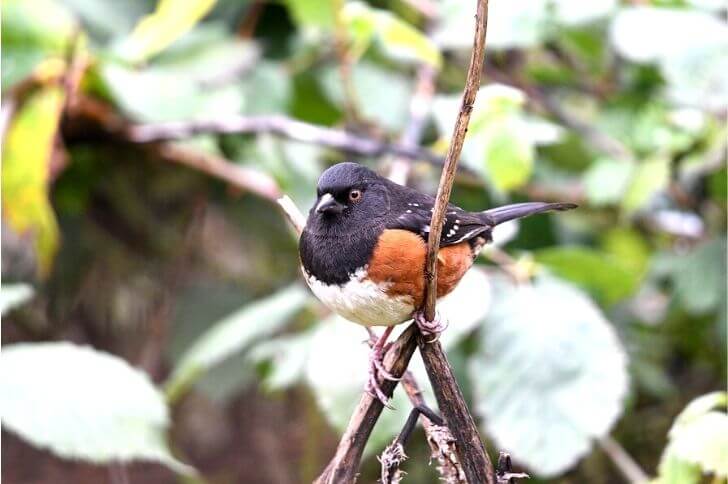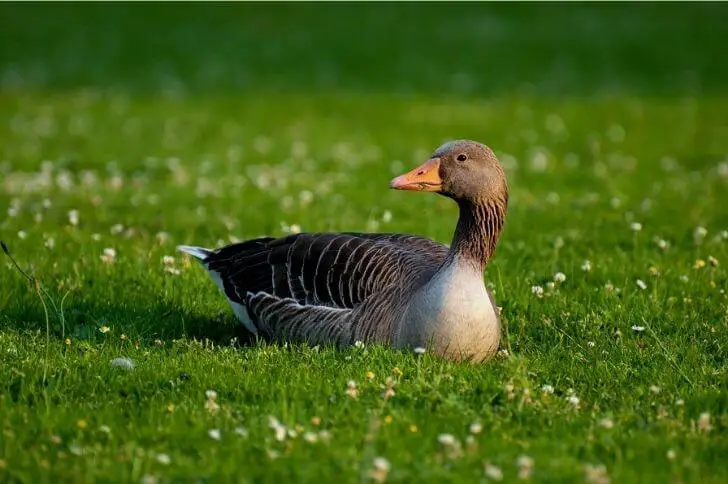From their distinctive coloring to their unique behaviors, brown and white birds are a beautiful sight. Whether they’re soaring high above or perched on a tree branch, these birds can be found in a variety of habitats all around the world.
There is something special about these stunning creatures that captivates people’s hearts and imaginations. Common brown birds with white include spotted towhees, wood thrush, female rose-breasted grosbeak and savannah sparrows.
List of Brown and White Birds
1. Spotted Towhee

ID:
The spotted towhee is one of the most recognizable birds in North America. This species is easily identifiable by its distinctive black, brown and white plumage, bright red eyes, and long tail feathers. To tell it apart from its cousin, the Eastern towhee, look at its wings and back. It should have white spots.
Habitat & more
Where do spotted towhees live? They prefer forest edges, dry thickets, and brushy fields. In the United States, these brown and white birds favor the western side.
During the non-breeding season they can be found in parts of Texas, Kansas, Oklahoma and New Mexico.
All-year round they inhabit Washington, Oregon, Nevada, California, and Utah.
For breeding, these black brown and white birds move to Canada, Montana, Wyoming, Idaho, and parts of Washington.
Also note, when nesting, spotted towhees construct a nest out of leaves and tree barks. The 4.5 inch wide nest is either placed at least 12 feet high or on the ground. A breeding pair can raise 1-3 broods, making them one of the most prolific breeders in the avian world.
2. Killdeer

ID:
Killdeer are one of the most common shorebirds in North America. They are medium-sized birds with a slightly pointed bill and two black bands across their chest. Their backs and wings are brown while underparts are white.
The typical adult is about 7.9-11 inches in length with a notable wingspan of 18.1-18.9 inches. They have a unique call, consisting of loud, shrill “killy-dee” calls that give them their name.
Habitat & more
Where do killdeers live? They prefer open areas. Lookout for them in mudflats and sandbars. In urban settings, killdeers can be seen in laws and parking lots. Also check in fields.
When nesting, these small brown and white birds do not build huge nests like other water birds such as herons. Instead, they find a shallow depression and add sticks or trash to mark the spot. Like the spotted towhees above, they can take care of up to 3 clutches each season.
3. Cooper’s Hawk

Cooper’s hawks are all-year residents in North America. These large, impressive birds of prey can be easily identified by their size and markings.
These birds are medium to large sized, with adult males reaching lengths of up to 15.3 inches in length and wingspans of up to 35.4 inches while females grow to about 17.7 inches and span to 39 inches.
Cooper’s hawks’ plumage varies depending on the region. For example, birds in the Pacific Northwest are darker compared to hawks in the east. But, colors are the same. Adults have a dark brown back and head. Note, Pacific Northwest birds have blue-gray backs.
On the underside, these birds are white with brown/cinnamon barring. Note their reddish eyes and barred tails.
Habitat & more
Do Cooper’s hawks visit backyards? They rarely do and if you spot them, they will mostly likely be hunting for smaller birds that visit bird feeders. Not a pretty sight!
They are woodland and forest birds. They raise 2-6 beautiful hawk babies each nesting season.
4. Ferruginous Hawk

ID:
Like Cooper’s hawks, ferruginous hawks are impressive. These hawks have a wingspan ranging from 52.4 to 55.9 inches and can reach lengths up to 2 feet. Ferruginous hawks are easily identifiable by their distinctive coloration and soaring flight patterns.
The overall plumage is usually a light, sandy-brown color with white underparts. Other distinguishing features include yellow feathered legs and feet, as well as a hooked bill.
Habitat & more:
Like the towhees above, these brown and white birds of prey prefer the western side of North America. They breed in the North; Montana, Indiana, North Dakota, South Dakota, Oregon, Washington, and Wyoming.
They winter in Texas, New Mexico, California and Oklahoma. All year round, ferruginous hawks can be found in parts of Arizona, New Mexico, and Colorado.
When breeding, these large birds of prey build nests on elevated places and trees; up to 65 feet. They raise up to 8 babies. They can be found in solitary or in pairs. Note; these hawks can be quite aggressive when breeding.
Related read: Check different brown birds with long tails
5. Wood Thrush

ID:
Seen a brown and white spotted bird? If you live in the eastern United States, chances are you’ve come across a wood thrush. Scientifically called hylocichla mustelina, the wood thrush is a small migratory songbird native to eastern states.
It is easily recognizable by its rusty-brown upperparts, white underparts and black spots that run from its throats down its sides. Belly is pure white. Also notice the white eyering. How large are these thrushes? They are about 7-9 inches, the same size as northern cardinals.
Their “ee-oh-lay” songs and “bup-bup” sounds also make identification easy.
Habitat & more:
The wood thrush prefers dense forests with plenty of red maple, beech, pines, oaks, and sweet gum trees. They mainly eat woodlice, caterpillars, flies, and beetles. Fruits include blueberries, elderberries, and fox grapes..
In addition, they often build nests in tree cavities or in shrubs close to the ground where they lay up to four eggs at one time during breeding season which is usually from March lasting to July. They can raise two broods.
6. African Fish Eagle

ID:
The African fish eagle, also known as the African sea eagle, is a majestic bird of prey found throughout Sub-Saharan Africa. This large bird can typically be identified by its long, snow white head and neck and brown body with distinctive black wings. It is one of the most recognizable birds in Africa due to its loud call, which has been described as a “weee-aht” or a “heeah-heeah.”
In addition to their unique coloring and distinct call, African fish eagles are also recognizable for their large size; they typically measure up to 30 inches long with a wingspan reaching over 7 feet wide. Like with most birds of prey, females have larger bodies.
Habitat & more:
How long do African fish eagles live? Average life expectancy is 24 years. Where do they live? They are common in South Africa, Botswana and Malawi. They are monogamous, living near bodies of water.
Their feet have rough toes, callus-like structures, that help them snatch up unsuspecting fish from below.
7. Bornean Frogmouth
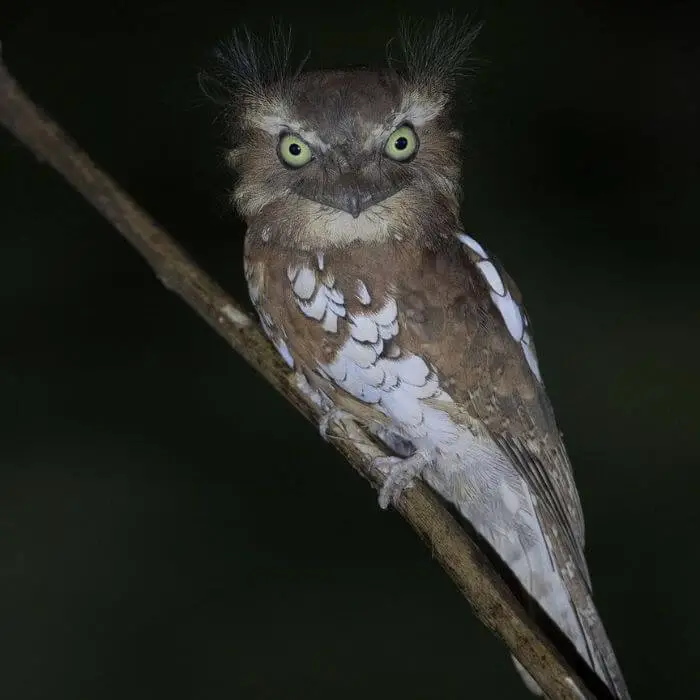
ID:
Frogmouths have been termed as the most instagrammable birds. From their unique faces to long tails, they are fascinating creatures.
This unique species can be identified by its large, round head and wide eyes, giving it an owl-like appearance. It has a unique frogmouth-shaped bill and distinctive face feathers ‘whiskers’ that give it an unmistakable look. The body is typically brownish with white spots on its chest or belly.
Habitat & more
This nocturnal creature prefers to hide during the day in dense foliage near water sources, where they use their powerful beaks to catch prey such as insects, worms and other small animals. During breeding season they become more active at night when they are seen singing loud calls resembling that of frogs.
The Bornean frogmouth lives in the tropical rainforests of the island of Borneo.
8. Brown Thrasher

ID:
Brown Thrashers are one of the largest and most vocal members of the thrasher family. They are the same size as robins; about 9.1-11.8 inches in length and span up to 12.6 inches.
These birds can be identified by their long, slightly curved bills and cinnamon-brown feathers above. White underside has black and brown streaks. Notice the yellow eyes and white/black wingbars.
Habitat & more:
Do brown thrashers visit bird feeders? Yes, if you offer food to these brown birds with long tails, they’ll be sure to visit your backyard.
Also, this brown and white bird prefers a variety of habitats including open fields, hedgerows, woodlands, residential areas, parks, gardens, and even suburban backyards. It typically feeds on nuts, seeds, and some insects like beetles and wire-worms.
They also have an impressive singing ability; they can learn up to 1100 different songs in one year!
9. Banded Bay Cuckoo

ID:
Slender and beautiful, the banded bay cuckoo is another type of brown and white bird that calls Southeast Asia home.
With its distinctive barred feathers and distinct call, this species can be identified by sight and sound.
These birds typically have brown backs with black barring and whitish underparts with dark barring. Sexes are alike.
Habitat & more:
Where do banded bay cuckoos live? They are common in Southeast Asia. Like other cuckoos, these medium size brown and white birds are brood parasites. They rely on red-whiskered bulbuls and scarlet minivets to raise their babies.
10. Banded Wren
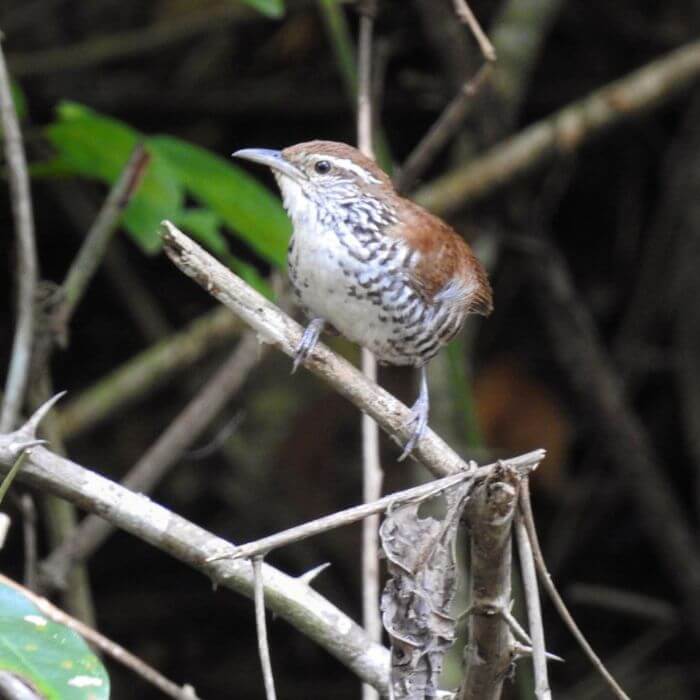
ID:
Preferring foothills and lowlands, banded wrens are spectacular birds from the wren family. It is related to the house wren, but with a larger body. Typically the adult banded wren is about 5.3 inches in length.
This bird has an overall brownish color with a white throat and a black and white barred belly. ,. Its tail is also brown with dark barring. It has two prominent white stripes above each eye which can often be seen when it is perched on a branch or wire. Its short bill curves down slightly at the end, distinguishing it from other similar species in the same family.
The banded wren’s loud, cheery song is composed of several notes and trills that typically last between three to five seconds long, making it easy to identify even without sight. Also listen for ‘kert rrruk’ notes.
Habitat & more:
These wrens favor thickets, thorn forests and woodlands. They mainly consume spiders and smaller invertebrates.
11. Rose-breasted Grosbeak (Female)

ID:
The Rose-breasted Grosbeak is a distinctive and beautiful songbird whose female counterpart can be difficult to identify because she resembles some sparrows.
Like sparrows, female rose-breasted grosbeaks are overall brownish with white eyebrows and pure white spots on their wings. Also, like the males of these species they have pinkish canonical bills that come in handy when hunting bees, beetles, moths and butterflies.
Habitat & more:
This bird is monogamous. She chooses a nesting site and with the help of her mate builds a 3-6 inch nest out of decayed leaves, twigs and grasses. She can raise up to two clutches.
12. Chocolate-backed Kingfisher

ID:
Kingfishers standout and the chocolate-backed kingfisher is no different. This little brown bird is remarkable because: Its dark brown back and brownish head and neck are unique to this species. Two, the brilliant blue patches on their wings and tails are also unique to this kingfisher. Also, this small brown bird has a pure white chest and bell.
Chocolate-backed kingfishers are also unique because of the large red bills and noticeable eyerings.
Habitat & more:
Where can you find these colorful birds? This small bird is found primarily in parts of Western Africa.
They spend their day perched on tall trees near clearings. They mainly feed on grasshoppers and termites.
13. Savannah Sparrow
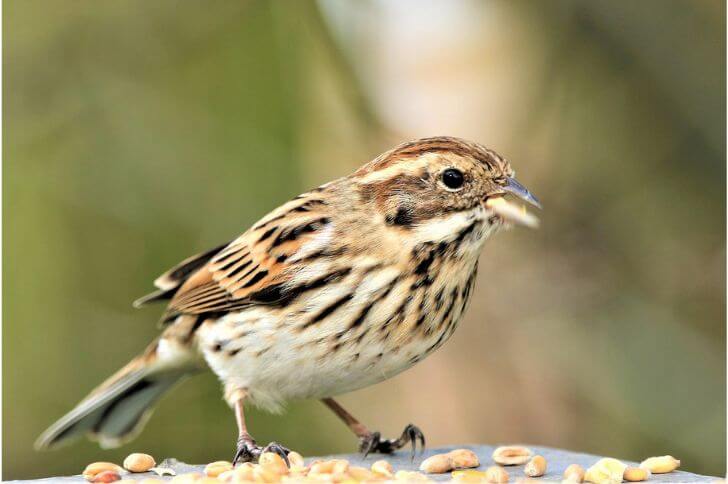
ID:
Savannah sparrows are unmistakable. With its brown upper body and white underbody that are both streaked with black markings, these birds are widespread.
On average, the savannah sparrow is about 4.3-5.9 inches in length. Its head is small and tail is short, giving its body a roundish look. Note the beautiful yellow eyebrows.
Habitat & more:
This brown and white bird favors areas with few trees. Look for it in roadsides, pastures, and cultivated feeds. How long do sparrows live? Between 5-6 years. Their population keeps growing because they can take care of up to 4 broods in one nesting season.
FAQs
What is a brown bird with a white chest?
Brown thrashers also have reddish-brown feathers on their backs, while their undersides are white with brown streaks. They have bright yellow eyes set against a brownish head.
What is a brown bird with a white rump?
The northern flicker has a brownish body with black spots and bars on its wings and back. Its rump is pure white and is visible when the bird stretches its wings or is in flight.
In addition to its vibrant coloration, the northern flicker also has unique feather patterns that set it apart from other birds in its family.
What kind of hawk is brown and white?
Ferruginous Hawk. This majestic species is well-known for its warm brown tones on its back and a snow white underbody.
What bird is brown with white wings?
Killdeers. These shorebirds are brownish above with white underwings. Also note the white patches on their wings.
What bird has a white head and a brown body?
African fish eagles. These large birds of prey have a snow white head with a yellow bill. The rest of their body is dark brown with black wings.
What is a brown bird with a white stripe above its eye?
Bewick’s wren. These birds have brownish-gray upperparts with bold white eyebrow stripes. The tail is often held cocked up and features bold black-and-white bars on the underside. Its this bill is slightly curved downward.
sources:
https://www.allaboutbirds.org/guide/Bewicks_Wren/id
https://en.wikipedia.org/wiki/Spotted_towhee
https://en.wikipedia.org/wiki/African_fish_eagle
Hi fellow bird watcher. Welcome to our small corner of the world. At the spanishbirdguides.com our mission is to share with other bird watchers the things we love about birds, where to go bird watching within the United States, and more. I’d also love to hear from you. Feel free to contact me about your bird watching escapades, share videos, photos and more.
